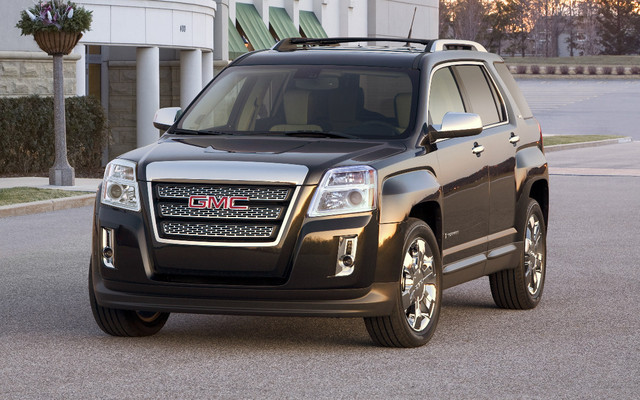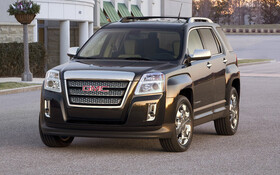The 2010 GMC Terrain: The same, but different

| Strong points |
|
|---|---|
| Weak points |
|
Since its reincarnation as a company free from bankruptcy and enormous debt, General Motors has unveiled interesting new vehicles after interesting new vehicles. The hope is that people will forget their negative preconceived notions of the former world number one’s products since it’s now offering vehicles that are truly able to measure up to all rival models in almost every category. So, it’s no coincidence that this manufacturer is urging people to compare its products to others and to return them if they aren’t to your liking.
In the compact crossover category, the Chevrolet Equinox is enjoying so much success that GM was forced to increase its production capacity. We know that one of the reasons for this manufacturer’s financial collapse was the multitude of almost identical models that were battling for the same clientele. The new and improved General Motors has been careful not to make the same mistake. For example, the new GMC Terrain has the same platform and mechanical components as the Chevrolet Equinox, but it would be false to say that they were identical twins. The manufacturer seems to have finally learned its lesson and although they have several things in common, these two vehicles are sufficiently different from one another to attract a varied clientele.
Original cars
When you compare the two products side by side, it’s easy to tell them apart. They didn’t settle – as they did in the past, unfortunately – for just modifying the grille and logos. First of all, there’s an obvious difference when it comes to the grille. The Chevrolet has a grille crossed by a large horizontal bar with the famous Chevy bow tie dead centre. With the GMC, the stylists didn’t hesitate to use the GMC chrome front grille with those three letters prominently displayed in the centre. The side panels are also very different from one another. The Equinox has very round wheel wells while the Terrain flexes its muscles with reasonably square wheel wells. It’s definitely more macho, but whether it’s more elegant is debatable. Finally and also to make it look tougher, the Terrain’s tail end isn’t as round, while the C-pillar is vertical, unlike that of the Chevrolet, which is inclined for a slightly sportier look. In both cases, the stylists used chrome plates in the back to give the overall look greater impact.
Designers are often hard-pressed to make two vehicles with common origins distinctive specially with the dashboard. However, as with the body, the lines are excellent. The Terrain’s stylists played up the aluminium accents, which contrast with the dashboard’s dark plastics. The air vents and the climate and audio controls are in the same place, but the layout is such that it doesn’t seem like a copy. The same goes for the main dials, which are circular in the GMC and elliptical in the Chevrolet. Also of note are the graphics used for the LCD screen, which are very unique to the Terrain and give it a little something extra. In both cases, the finish and materials used are very high quality, a new trend with GM that gets our wholehearted approval.
The Terrain is roomy and the cargo area is reasonably generous. The rear seat can be moved forward or backward by 203 mm in order to maximize the cargo area. Finally, the baggage hold is accessed using a motorized rear hatch, an accessory that is quickly becoming a must. Once you try one, you have to have one...
Four cylinders...Why not?
When a vehicle in this category came on the market a few years ago offering the choice of a four-cylinder engine or a V6, it was generally recommended that you take the V6 engine. But times have changed and engineers are now able to develop sufficiently powerful four-cylinder engines that feature very reasonable fuel consumption, so you’re not automatically obliged to opt for the V6. In this case, you should take the V6 if you’re going for the all-wheel drive and if you need to tow relatively heavy loads. Our test vehicle was, just like the Chevrolet Equinox that we previously tested, powered by a 2.4-litre, 184-hp four-cylinder engine paired with a six-speed automatic gearbox. As for the 3.0-litre V6, it features 264 horsepower and offers a towing capacity of 1,588 kilos, compared to 680 kg for the 2.4-litre engine.
I want to specify something about the new generation of four-cylinder engines recently put on the market. With the use of infinitely variable valve timing, these adapt a lot better to different driving situations since engine hesitations are practically a thing of the past. If you’ve ever driven a vehicle with a conventional four-cylinder engine that struggled on uphill climbs, you have definitely heard the noise of the valves, a telltale sign of an engine in difficulty. With infinitely variable valve timing, that has all but disappeared.
Like most of the models in this category, the Terrain uses a four-wheel independent suspension, front and rear disc brakes as well as electrical power steering. This new type of steering assist is being used because it’s lighter and helps lower fuel consumption. Fortunately, it has been refined over the years and the lack of feedback that was so loudly criticized a few months ago is now history, more or less.
Forget the past
It’s hard to talk about the past in the case of the Terrain since it is GMC’s first incursion in this category. But as it’s very closely derived from the Chevrolet Equinox, it’s good to look back a little and talk about the Chevy’s handling. Indeed, while the first generation of this all-purpose Chevrolet had an elegant shape, its road manners left a lot to be desired. Handling was a lot like the performances, about average, but that was precisely the problem: it was a lot like all the others. This time, the engineers refined the platform, redesigned the suspensions and made the body a lot more rigid – so much so that driving a new generation Terrain or Equinox will be enough to place these models among the best in the category in terms of handling and fun.
Not only did the four-cylinder engine do a good job, it turned out to be very restrained when it came to fuel consumption with an average of a little more than 10 litres per 100 km while accelerations and pick-up were better than average. The six-speed automatic transmission that doesn’t hunt needlessly is brilliant and merits mention. You can even choose Eco mode, which helps to optimize fuel economy using specially calculated gear changes patterns in order to reduce fuel consumption. Performance suffers a little, but it’s a small price to pay for the savings that come with it.
Basically, the GMC Terrain distinguishes itself enough from the Chevrolet Equinox to attract a different clientele. Its soundproofing seemed better, its look is more aggressive and its dashboard is slightly better. However, whether you opt for the Chevrolet or the Terrain, you’re going to get a superior vehicle. If there’s a major drawback, it’s that General Motors seems to have adopted a marketing strategy similar to that of Toyota by offering a reasonably well-equipped vehicle at a more than competitive price. But if you allow yourself to be seduced by the optional features, your price will climb quickly, so don’t forget to bring along your calculator when the time comes to choose the right model and the right options.











